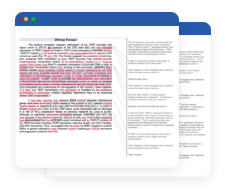動詞時態
所有的動詞都有時態。時態是動詞的一種屬性,表示事件發生的時間。時態主要有三種,每一種時態都包括四個狀態。這三種時態是過去式、現在式、未來式。這四個狀態是一般狀態、完成狀態、進行狀態、完成進行狀態。
動詞時態及其用法
不同的時態用來描述某個事件究竟是在過去發生的,還是現在正在發生的,或者是未來將要發生的。如果不確定自己是否使用了正確的時態,參考下方詳細的動詞時態說明並檢查文件,或是使用文法檢查器迅速找出並修正動詞使用上的不一致。
| 動詞時態 | 動詞用法 | 使用時機 | 例句 (以動詞run為例) |
|---|---|---|---|
| 現在簡單式 |
run |
用於與時間無關的陳述 |
He runs at the park frequently. |
| 現在進行式 |
is/are/am running |
用於描述正在發生的事情 |
He is running at the park now. |
| 現在完成式 |
has/have run |
用於描述過去開始的但可能會持續下去的事情,或者用於強調過去發生的事情對現在的影響 |
He has run every day this week and now looks healthier. |
| 現在完成進行式 |
has/have been running |
用於描述過去開始的但現在正在發生的事情,也用於強調過去發生的事情對現在的影響 |
He has been running for the past hour, and now he must get ready for work. |
| 過去簡單式 |
ran |
用於描述過去發生的事情 |
He ran every day for the whole of April. |
| 過去進行式 |
was/were running |
用於強調過去某一事件正在進行的性質,尤指與另一事件有關時 |
He was running at the park when he sprained his ankle. |
| 過去完成式 |
had run |
用於描述發生在過去一個事件之前的另一個事件 |
He had run daily before he sprained his ankle. |
| 過去完成進行式 |
had been running |
用於描述過去開始的但一直持續到現在或最近才剛結束的事情 |
He had been running at the park for two hours, and he had to get ready for work. |
| 未來簡單式 |
will run |
用於描述將來會發生的事情 |
He will run every day next month to prepare for the marathon. |
| 未來進行式 |
will be running |
用於描述將來可能會持續一段時間的事情 |
He will be running every day to train for the marathon. |
| 未來完成式 |
will have run |
用於描述從現在到將來某個時刻將要完成的事情 |
He will have run a marathon by the end of next month. |
| 未來完成進行式 |
will have been running |
用於描述將會持續到未來某一特定時刻的事件,也用於強調事件的預期持續時間 |
He will have been running daily for one month by the time of the marathon. |
現在簡單式,過去簡單式,未來簡單式
時態的第一個狀態是“一般狀態”。現在簡單式用來描述現在正在發生或有規律地發生的事件。過去簡單式用來描述過去發生的事件。未來簡單式用來描述尚未發生的事件。
什麼時候使用現在簡單式
現在簡單式最常見的用法是描述正在發生的事件。然而,現在簡單式也用於不受時間推移影響的事實或有規律地發生的事件。
關於事實和解釋的描述
事實、理論和科學解釋與時間無關。因此,涉及這些內容的陳述都應該使用現在式。
- 例句
- The mass of a closed system remains constant over time.
- 例句
- The results demonstrate that the proposed model can effectively increase the efficiency of data collection.
關於文本內容的描述
在許多寫作格式指南中,必須使用現在式來描述文本或課程的內容。這是因為就像事實和解釋一樣,文本內容也不受時間影響。.
- 例句
- Tolstoy’s Anna Karenina begins with the line, “Happy families are all alike; every unhappy family is unhappy in its own way.”
- 例句
- In their 2015 paper, Mishra et al. state that a wide network of health facilities, community workers, and volunteers is characteristic of Nepal’s health system.
什麼時候使用過去簡單式
過去簡單式用來描述在過去開始和結束的事件。這種時態常用於描述某項研究工作的步驟、解釋歷史事件或報導過去發生的新聞事件。
報告研究工作步驟
過去簡單式通常用來描述研究的方法和結果。這是因為該項研究在大多數情況下都是在過去進行的,而且其結果也是在過去獲得的。在論文的方法論述部分,經常使用過去簡單式的被動語態,如下面的例子所示。
- 例句
- The compound was synthesized from graphite following the proposed method.
- 例句
- A quantitative thermogravimetric analysis was performed.
特指過去發生的事情
過去式最顯而易見的用法是描述過去發生的事情。這種事情可以是一個新聞或歷史事件,也可以是昨天發生的一次購物之旅。
- 例句
- World War II officially ended on September 2, 1945..
- 例句
- I visited my grandmother in Montauk last weekend.
什麼時候使用未來簡單式
未來簡單式用於假設、預測或將來發生(或將來可能發生)的事件。注意,有些副詞可以放在“will”和主要動詞之間,正如下面第二個例子所示。
- 例句
- We hypothesize that the fabricated composite will exhibit good thermal conductivity.
- 例句
- The proposed approach will likely facilitate the development of thermally conductive materials.
- 例句
- I will visit my cousins in Seattle next month.
使用其他動詞代替未來式
一般未來式的動詞通常意味著高度的確定性。因此,在學術寫作中如果不想這麼確定,那麼可以使用其他更為“謹慎”的動詞,例如expect、suppose和assume。使用諸如may、might或could等情態動詞也能表達可能性,而不會暗示確定性
- 例句
- The proposed approach may facilitate the development of thermally conductive materials.
- 例句
- I might visit my cousins in Seattle next month.
現在完成式,過去完成式,未來完成式
時態的第二個狀態是“完成狀態”。完成式用來表示已經完成、正在完成或將要完成的事件或行為。
什麼時候使用現在完成式
現在完成式最常用來描述過去開始的事情,但很可能會繼續下去,或者強調過去發生的事情對現在情況的影響。但是,它也可以用來描述在過去不確定的時間點上發生的事情。
描述在過去某個並未指定的時間發生的事件
現在完成式可以表示事件發生在過去的某個並未指定的時間。
- 例句
- Lana has made breakfast for her housemates.
- 例句
- I have met Keanu Reeves once before.
指向過去的研究
現在完成式強調一個動作已經完成。因此,當提到過去的研究時,如果工作已經完成,而且不強調具體的過去動作,經常可以使用現在完成式。
- 例句
- Previous studies have confirmed that this composite material exhibits good thermal conductivity.
- 例句
- We have previously developed a novel platform for large-scale data collection.
強調過去的工作對當前的重要性
現在完成式也用於強調過去的事件對現在的影響。它經常用來強調過去的工作對於現在的重要性。
- 例句
- As recent research [1],[5],[24],[26] has demonstrated, the third composite has high fragility, which makes practical application infeasible despite the composite’s high thermal conductivity.
什麼時候使用過去完成式
過去完成式用於描述發生在另一個過去事件之前的過去事件。它不常用於學術寫作,但是經常用於其他類型的寫作,以安排敘事性事件。
- 例句
- Tommy was surprised to see that Lana had painted her room bright yellow.
- 例句
- I thought, if I had caused the cloud, it was my duty to make an effort to dispel it.
什麼時候使用未來完成式
未來完成式用來描述從現在到將來某個特定時刻之間將要完成的事情。與過去完成式一樣,這種時態在學術寫作中並不常見,但是可以用於安排敘事性事件。
- 例句
- Lana will have finished painting her room by tomorrow.
- 例句
- By the end of the week, I will have left for Australia.
現在進行式,過去進行式,未來進行式
時態的第三個狀態是“進行狀態”。進行式用來表示事件正在進行的性質。
什麼時候使用現在進行式
現在進行式用來描述正在發生的事件。這個動詞時態在學術寫作中不常用,但是在日常寫作和其他寫作中很常見。然而,現在進行式也可以用來描述某一事件在將來發生的可能性或將來要做某事的意圖。這在討論未來的研究或研究的可能性結果時很有用。
討論當前或正在進行的行動或事件
現在進行式最常見的用法是描述正在發生的動作或事件。
- 例句
- Lana is painting her room a bright sunflower yellow.
討論未來的事件或研究
在學術寫作中,現在進行式經常用來討論預期的結果和未來的研究,這是因為現在進行式也可以用來描述意圖。
- 例句
- We are expecting future studies to help further elucidate the mechanics behind this result.
- 例句
- We are planning to further investigate the mechanics behind this result.
什麼時候使用過去進行式
過去進行式用來強調過去的事件正在發生,特別是當它與過去的另一個事件或行為有關時。
- 例句
- Lara was painting her room until her brother interrupted.
- 例句
- The company was still recovering from the recession when its CFO died unexpectedly.
什麼時候使用未來進行式
未來進行式用來描述可能會持續一段時間的事件。
- 例句
- Lana will be painting her room yellow this upcoming weekend.
- 例句
- I will be studying for my exam later.
使用過去、現在或未來的完成進行式
過去進行式和現在完成進行式用來描述發生在過去但正在進行的事件,也用來強調過去的事件或行為對現在的影響。未來進行式表示將持續到未來某一特定時刻的事件,強調事件的預期持續時間。下面三個例子分別對應過去完成進行式、現在完成進行式和未來完成進行式。
- 過去完成進行式
- He had been learning Japanese for six months when he got the opportunity to visit Japan.
- 現在完成進行式
- He has been learning Japanese for almost three years.
- 未來完成進行式
- Next month, he will have been learning Japanese for three years.









